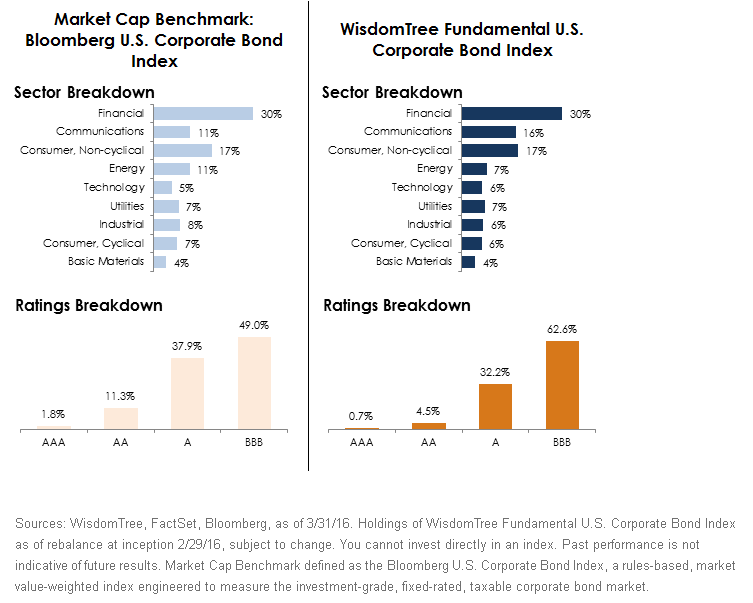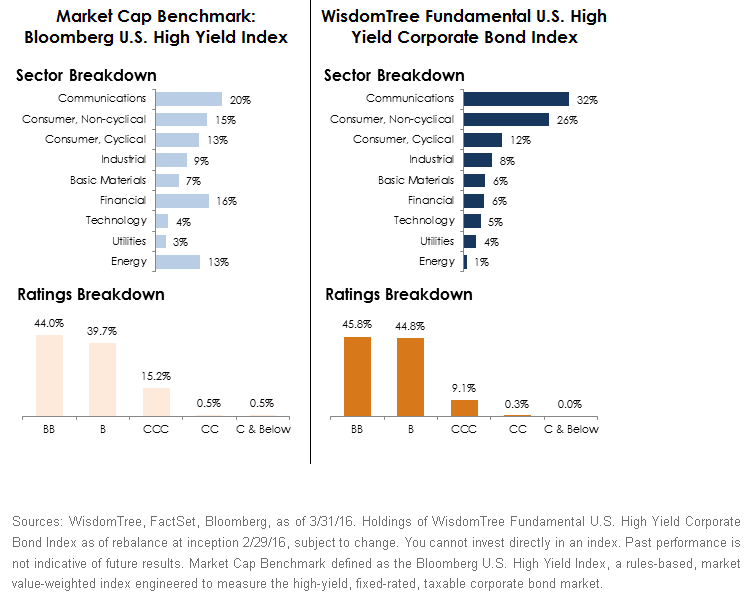
Head of Fixed Income Strategy
Follow Kevin Flanagan
The recent
Federal Open Market Committee (FOMC) meeting and subsequent release of Q1 real
gross domestic product (GDP) data seemed to underscore the point that U.S.
interest rates will more than likely remain in a range-bound pattern. As a result, fixed income investors have increasingly turned their attention to the U.S.
corporate bond market as a source to potentially improve their income opportunities. WisdomTree continues to see more relative value in
investment-grade (IG) corporates than in interest-sensitive vehicles such as
Treasuries, and our preferred strategy is to focus on a qualitative approach while tilting for income.
Prior to the evolution of
smart beta, or fundamentally weighted index methodologies, investors relied on a
market cap-weighted approach to investing. For the fixed income investor, this is actually a counterintuitive approach, as it increases exposure to companies simply because they have issued more debt. As a result, the market cap-weighted strategy does not necessarily focus on
credit quality, an important consideration in any fixed income asset allocation. Given the heightened level of credit concerns (downgrades and defaults) permeating market psychology, we believe fixed income investors would benefit from getting back to the
fundamentals.
Within our smart beta, or fundamental, approach, we define the investable corporate bond universe focusing on publicly traded, U.S.- domiciled issues. In our April 27 blog post
“U.S. Fixed Income: Get Smart … Beta”, we highlighted our fixed income team’s work in screening for quality in both the IG and
high-yield (HY) arenas. After implementing the fundamental screening process (for IG, we cut the worst 20% from the defined universe; for HY, we eliminate all issuers with negative free cash flow and also remove the 5% with the lowest estimated
liquidity), we then redefine the post-fundamental- cut universe and tilt for income. Within this process, we (1)
score the remaining issues: utilize
spreads versus like-
maturity Treasuries, consider
duration/interest rate risk and factor in the context of potential default risk; (2)
rank the issues: compare to other credits within the same industry groups (Financials versus Financials, Industrials versus Industrials, etc.) and (3)
weight: tilt toward issues based on the results of the scoring/rank steps.
The accompanying charts illustrate the final outcome of the WisdomTree fundamental fixed income strategy as compared to the market cap benchmark. Let’s first take a look at the sector breakdown. In IG, the most noteworthy difference is that our smart beta approach results in an over-weight to the Communications grouping and under-weighting to Energy issues. For HY, our methodology results in a visible over-weight to Communications and Non-cyclical Consumer, while under-weighting the Energy and Financial sectors. Notwithstanding the recent bounce, crude oil prices have dropped in a precipitous fashion over the last two years, and this action, as well as potential knock-on effects, has given rise to the aforementioned credit concerns rearing up throughout this year and perhaps 2017, once again placing an emphasis on quality investments.
From a ratings perspective, the fundamental strategy for IG tilts toward the BBB category versus the market cap benchmark. This difference is the direct result of the screening and weighting process whereby we tilt toward the higher- quality BBBs in order to add back income. Within HY, the weighting shifts from the CCC and below ratings into the BB and single-B groupings.
WisdomTree Fundamental U.S. Corporate Bond Index Comparison
 WisdomTree Fundamental U.S. High Yield Corporate Bond Index Comparison
WisdomTree Fundamental U.S. High Yield Corporate Bond Index Comparison
 Conclusion
Conclusion
The WisdomTree fundamental fixed income funds—the
WisdomTree Fundamental U.S. Corporate Bond Fund (WFIG), the
WisdomTree Fundamental U.S. Short-Term Corporate Bond Fund (SFIG), the
WisdomTree Fundamental U.S. High Yield Corporate Bond Fund (WFHY) and the
WisdomTree Fundamental U.S. Short-Term High Yield Corporate Bond Fund (SFHY)—can be used as either a substitute or complement in a fixed income portfolio. They offer solutions for fixed income investors who are searching for investments that provide relative income opportunities in an environment in which increased credit quality is desired. These Funds fit into WisdomTree’s suite of fixed income products, potentially serving as an allocation to U.S.- based fixed income, specifically within the credit sector.
Important Risks Related to this Article
Credit ratings apply to the underlying holdings of the Fund, not to the Fund itself. Standard &Poor’s, Moody’s and Fitch study the financial condition of an entity to ascertain its creditworthiness. The credit ratings reflect the rating agency’s opinion of the holdings’ financial condition and histories. The ratings displayed are based on the highest of each portfolio constituent as currently rated by Standard & Poor’s, Moody’s or Fitch. Long- term ratings are generally measured on a scale ranging from AAA (highest) to D (lowest), while short- term ratings are generally measured on a scale ranging from A-1 to C.
Fixed income investments are subject to interest rate risk; their value will normally decline as interest rates rise. Fixed income investments are also subject to credit risk, the risk that the issuer of a bond will fail to pay interest and principal in a timely manner or that negative perceptions of the issuer’s ability to make such payments will cause the price of that bond to decline.
High-yield or “junk” bonds have lower credit ratings and involve a greater risk to principal.
While the Funds attempt to limit credit and counterparty exposure, the value of an investment in the Funds may change quickly and without warning in response to issuer or counterparty defaults and changes in the credit ratings of each Fund’s portfolio investments. Please read each Fund’s prospectus for specific details regarding each Fund’s risk profile.


 WisdomTree Fundamental U.S. High Yield Corporate Bond Index Comparison
WisdomTree Fundamental U.S. High Yield Corporate Bond Index Comparison
 Conclusion
The WisdomTree fundamental fixed income funds—the WisdomTree Fundamental U.S. Corporate Bond Fund (WFIG), the WisdomTree Fundamental U.S. Short-Term Corporate Bond Fund (SFIG), the WisdomTree Fundamental U.S. High Yield Corporate Bond Fund (WFHY) and the WisdomTree Fundamental U.S. Short-Term High Yield Corporate Bond Fund (SFHY)—can be used as either a substitute or complement in a fixed income portfolio. They offer solutions for fixed income investors who are searching for investments that provide relative income opportunities in an environment in which increased credit quality is desired. These Funds fit into WisdomTree’s suite of fixed income products, potentially serving as an allocation to U.S.- based fixed income, specifically within the credit sector.
Conclusion
The WisdomTree fundamental fixed income funds—the WisdomTree Fundamental U.S. Corporate Bond Fund (WFIG), the WisdomTree Fundamental U.S. Short-Term Corporate Bond Fund (SFIG), the WisdomTree Fundamental U.S. High Yield Corporate Bond Fund (WFHY) and the WisdomTree Fundamental U.S. Short-Term High Yield Corporate Bond Fund (SFHY)—can be used as either a substitute or complement in a fixed income portfolio. They offer solutions for fixed income investors who are searching for investments that provide relative income opportunities in an environment in which increased credit quality is desired. These Funds fit into WisdomTree’s suite of fixed income products, potentially serving as an allocation to U.S.- based fixed income, specifically within the credit sector.

